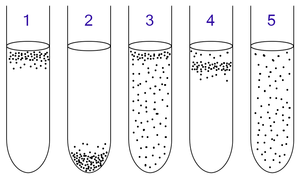
Back بكتيريا هوائية إجبارية Arabic Aerobio estricto Spanish Aerobio hertsi Basque هوازی اجباری Persian Aerobio obrigado Galician אווירני אובליגטורי HE अविकल्पी वायुजीव Hindi 절대호기성 미생물 Korean Aerob obligatoryjny Polish Облигатные аэробы Russian

1: Obligate aerobes need oxygen because they cannot ferment or respire anaerobically. They gather at the top of the tube where the oxygen concentration is highest.
2: Obligate anaerobes are poisoned by oxygen, so they gather at the bottom of the tube where the oxygen concentration is lowest.
3: Facultative anaerobes can grow with or without oxygen because they can metabolise energy aerobically or anaerobically. They gather mostly at the top because aerobic respiration generates more ATP than either fermentation or anaerobic respiration.
4: Microaerophiles need oxygen because they cannot ferment or respire anaerobically. However, they are poisoned by high concentrations of oxygen. They gather in the upper part of the test tube but not the very top.
5: Aerotolerant organisms do not require oxygen as they metabolise energy anaerobically. Unlike obligate anaerobes however, they are not poisoned by oxygen. They can be found evenly spread throughout the test tube.
An obligate aerobe is an organism that requires oxygen to grow.[1] Through cellular respiration, these organisms use oxygen to metabolise substances, like sugars or fats, to obtain energy.[1][2] In this type of respiration, oxygen serves as the terminal electron acceptor for the electron transport chain.[1] Aerobic respiration has the advantage of yielding more energy (adenosine triphosphate or ATP) than fermentation or anaerobic respiration,[3] but obligate aerobes are subject to high levels of oxidative stress.[2]
| Group | Environment | O2 Effect | |
|---|---|---|---|
| Aerobic | Anaerobic | ||
| Obligate Aerobe | Growth | No growth | Required (used for aerobic respiration) |
| Obligate Anaerobe | No growth | Growth | Toxic |
| Facultative Anaerobe (Facultative Aerobe) | Growth | Growth | Not required for growth but used when available |
| Microaerophile | Growth if level is not too high | No growth | Required but at levels below 0.2 atm |
| Aerotolerant Anaerobe | Growth | Growth | Not required and not used |
- ^ a b c Prescott LM, Harley JP, Klein DA (1996). Microbiology (3rd ed.). Wm. C. Brown Publishers. pp. 130–131. ISBN 0-697-29390-4.
- ^ a b "Obligate aerobe - definition from Biology-Online.org." Biology Online. Biology-Online, n.d. Web. 12 Dec 2009. <http://www.biology-online.org/dictionary/Obligate_aerobe>
- ^ Hogg, S. (2005). Essential Microbiology (1st ed.). Wiley. pp. 99–100, 118–148. ISBN 0-471-49754-1.
- ^ WI, Kenneth Todar, Madison. "Nutrition and Growth of Bacteria". textbookofbacteriology.net. Retrieved 2021-04-20.
{{cite web}}: CS1 maint: multiple names: authors list (link)
© MMXXIII Rich X Search. We shall prevail. All rights reserved. Rich X Search